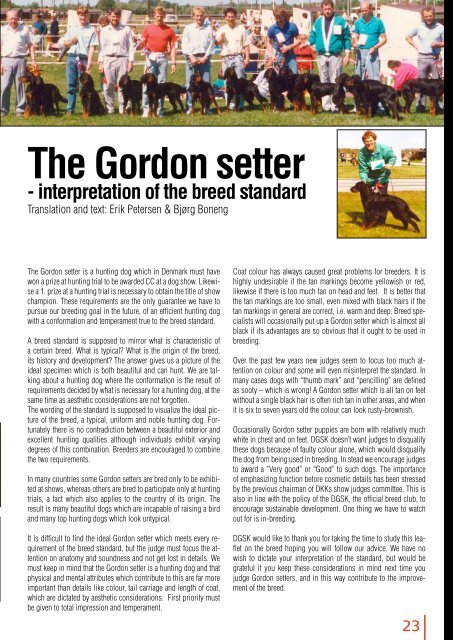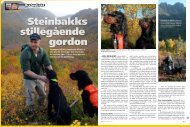RAcEKOMPENDIUM FOR GORDON sEttER - Kennel Aaen
RAcEKOMPENDIUM FOR GORDON sEttER - Kennel Aaen
RAcEKOMPENDIUM FOR GORDON sEttER - Kennel Aaen
Create successful ePaper yourself
Turn your PDF publications into a flip-book with our unique Google optimized e-Paper software.
The Gordon setter<br />
- interpretation of the breed standard<br />
Translation and text: Erik Petersen & Bjørg Boneng<br />
The Gordon setter is a hunting dog which in Denmark must have<br />
won a prize at hunting trial to be awarded CC at a dog show. Likewise<br />
a 1. prize at a hunting trial is necessary to obtain the title of show<br />
champion. These requirements are the only guarantee we have to<br />
pursue our breeding goal in the future, of an efficient hunting dog<br />
with a conformation and temperament true to the breed standard.<br />
A breed standard is supposed to mirror what is characteristic of<br />
a certain breed. What is typical? What is the origin of the breed,<br />
its history and development? The answer gives us a picture of the<br />
ideal specimen which is both beautiful and can hunt. We are talking<br />
about a hunting dog where the conformation is the result of<br />
requirements decided by what is necessary for a hunting dog, at the<br />
same time as aesthetic considerations are not forgotten.<br />
The wording of the standard is supposed to visualize the ideal picture<br />
of the breed, a typical, uniform and noble hunting dog. Fortunately<br />
there is no contradiction between a beautiful exterior and<br />
excellent hunting qualities although individuals exhibit varying<br />
degrees of this combination. Breeders are encouraged to combine<br />
the two requirements.<br />
In many countries some Gordon setters are bred only to be exhibited<br />
at shows, whereas others are bred to participate only at hunting<br />
trials, a fact which also applies to the country of its origin. The<br />
result is many beautiful dogs which are incapable of raising a bird<br />
and many top hunting dogs which look untypical.<br />
It is difficult to find the ideal Gordon setter which meets every requirement<br />
of the breed standard, but the judge must focus the attention<br />
on anatomy and soundness and not get lost in details. We<br />
must keep in mind that the Gordon setter is a hunting dog and that<br />
physical and mental attributes which contribute to this are far more<br />
important than details like colour, tail carriage and length of coat,<br />
which are dictated by aesthetic considerations. First priority must<br />
be given to total impression and temperament.<br />
Coat colour has always caused great problems for breeders. It is<br />
highly undesirable if the tan markings become yellowish or red,<br />
likewise if there is too much tan on head and feet. It is better that<br />
the tan markings are too small, even mixed with black hairs if the<br />
tan markings in general are correct, i.e. warm and deep. Breed specialists<br />
will occasionally put up a Gordon setter which is almost all<br />
black if its advantages are so obvious that it ought to be used in<br />
breeding.<br />
Over the past few years new judges seem to focus too much attention<br />
on colour and some will even misinterpret the standard. In<br />
many cases dogs with “thumb mark” and “pencilling” are defined<br />
as sooty – which is wrong! A Gordon setter which is all tan on feet<br />
without a single black hair is often rich tan in other areas, and when<br />
it is six to seven years old the colour can look rusty-brownish.<br />
Occasionally Gordon setter puppies are born with relatively much<br />
white in chest and on feet. DGSK doesn’t want judges to disqualify<br />
these dogs because of faulty colour alone, which would disqualify<br />
the dog from being used in breeding. In stead we encourage judges<br />
to award a ”Very good” or “Good” to such dogs. The importance<br />
of emphasizing function before cosmetic details has been stressed<br />
by the previous chairman of DKKs show judges committee. This is<br />
also in line with the policy of the DGSK, the official breed club, to<br />
encourage sustainable development. One thing we have to watch<br />
out for is in-breeding.<br />
DGSK would like to thank you for taking the time to study this leaflet<br />
on the breed hoping you will follow our advice. We have no<br />
wish to dictate your interpretation of the standard, but would be<br />
grateful if you keep these considerations in mind next time you<br />
judge Gordon setters, and in this way contribute to the improvement<br />
of the breed.<br />
23




